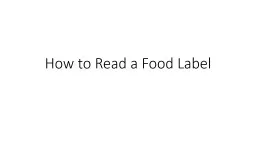

Grade Health Do Now What does eating in moderation mean Lesson Objectives Students will be able to Explain how reading a food label can help improve a persons eating habits Analyze the nutrition information on food labels to compare products ID: 927287
Download Presentation The PPT/PDF document "Reading a Food Label 7 th" is the property of its rightful owner. Permission is granted to download and print the materials on this web site for personal, non-commercial use only, and to display it on your personal computer provided you do not modify the materials and that you retain all copyright notices contained in the materials. By downloading content from our website, you accept the terms of this agreement.
Slide1
Reading a Food Label
7
th
Grade Health
Slide2Do Now!
What does eating in moderation mean?
Slide3Lesson Objectives
Students will be able to:
Explain how reading a food label can help improve a person’s eating habits.
Analyze the nutrition information on food labels to compare products.
Demonstrate how to use food labels to make healthy food choices.
Slide4Health Terms
Cholesterol
Gram
High blood pressure
Lean
Milligram
Saturated fat
Sodium
Trans fat
Slide5Food Labels
Food companies know that many people want to eat healthier. So they use many words on their food packages to get people to buy their products. Food may be labeled as “fat-free,” “low-fat,” “light” or “lean.” But a “fat-free” food may still be high in sugar and calories.
Slide6How a Food Label Can Help You
Food labels can help you:
Identify the amount of food in the listed serving size.
Identify the calories per serving of food.
Identify the amounts of various nutrients in a food.
Compare nutrient contents of different foods.
Slide7Anatomy of a Food Label
Why is it important to know the amount of food in the serving size listed on the label?
Knowing the amount of food in the serving size listed on the label can help determine nutrients and the calories for the food you eat.
For example, if you eat 3 cups of cereal for breakfast, and the serving size on the food label is 1 cup, you would have to multiply the nutrients and calories by 3 to determine how much you were getting.
Why is the information about calories and calories from fat included on the label?
This information is included to help you follow guidelines that recommend that teens get no more than 25-35% of their daily calories from fat.
Slide8Anatomy of a Food Label
Why should you limit the amount of fat, saturated fat, trans fat, cholesterol and sodium you eat?
Eating too much saturated or trans fat, cholesterol and sodium may increase your chance of getting heart disease, certain types of cancer and high blood pressure. Remember that trans fats are most often found in processed foods.
Why should you make sure you get enough vitamins A and C, and iron?
Eating the appropriate amount of nutrients promotes health and can help reduce the risk of some diseases. For example, Iron helps your red blood cells carry oxygen.
Slide9Anatomy of a Food Label
What does calcium do for your body?
Helps construct, form, and maintain bones and teeth, thereby reducing the occurrence of osteoporosis
Helps your muscles contract and your heart beat
Helps control blood pressure
Helps control nerve transmission and the release of neurotransmitters
Aids in blood clotting and wound healing
May also protect your body from health problems such as heart disease, high blood pressure, kidney stones, gum disease and colon cancer
Milk and other dairy products
contain calcium!
Slide10Anatomy of a Food Label
If you ate 1 serving of the food with the label shown on your paper, what percentage of the daily amount of vitamin C would you obtain?
If you ate 1 serving, you would get 60% of the total amount of vitamin C needed for the entire day.
The goal is to choose a variety of foods throughout the day that will provide a total of 100% of eat nutrient.
Complete: Label Detective